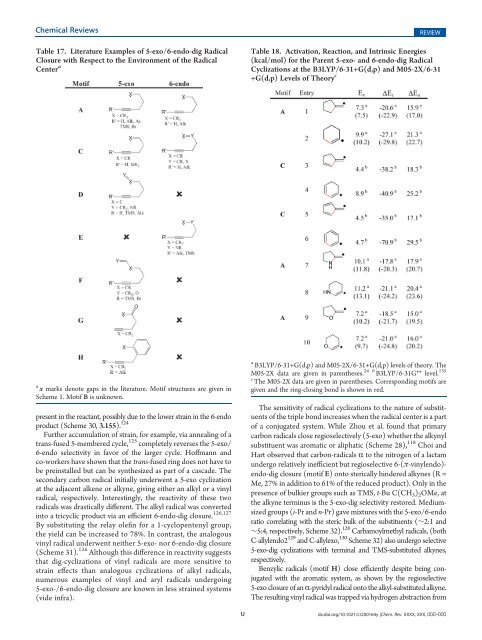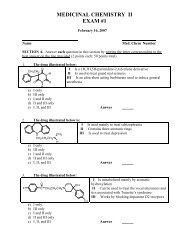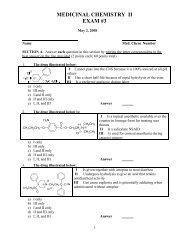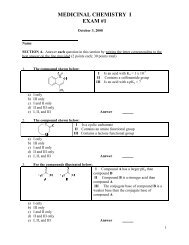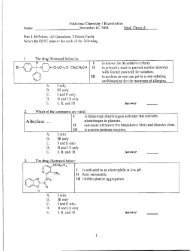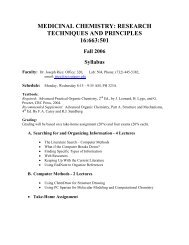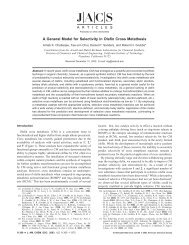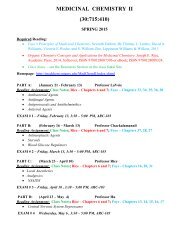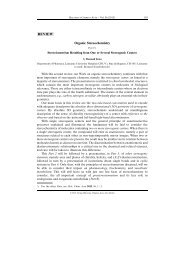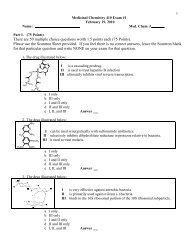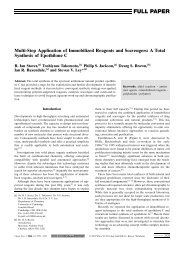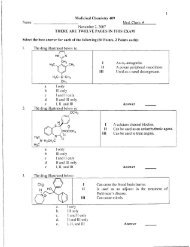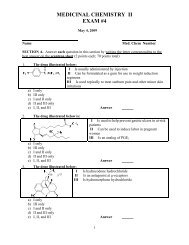Baldwin's Rules - Department of Medicinal Chemistry
Baldwin's Rules - Department of Medicinal Chemistry
Baldwin's Rules - Department of Medicinal Chemistry
Create successful ePaper yourself
Turn your PDF publications into a flip-book with our unique Google optimized e-Paper software.
Chemical Reviews REVIEW<br />
Table 17. Literature Examples <strong>of</strong> 5-exo/6-endo-dig Radical<br />
Closure with Respect to the Environment <strong>of</strong> the Radical<br />
Center a<br />
a x marks denote gaps in the literature. Motif structures are given in<br />
Scheme 1. Motif B is unknown.<br />
present in the reactant, possibly due to the lower strain in the 6-endo<br />
product (Scheme 30, 3.155). 124<br />
Further accumulation <strong>of</strong> strain, for example, via annealing <strong>of</strong> a<br />
trans-fused 5-membered cycle, 125 completely reverses the 5-exo/<br />
6-endo selectivity in favor <strong>of</strong> the larger cycle. H<strong>of</strong>fmann and<br />
co-workers have shown that the trans-fused ring does not have to<br />
be preinstalled but can be synthesized as part <strong>of</strong> a cascade. The<br />
secondary carbon radical initially underwent a 5-exo cyclization<br />
at the adjacent alkene or alkyne, giving either an alkyl or a vinyl<br />
radical, respectively. Interestingly, the reactivity <strong>of</strong> these two<br />
radicals was drastically different. The alkyl radical was converted<br />
into a tricyclic product via an efficient 6-endo-dig closure. 126,127<br />
By substituting the relay olefin for a 1-cyclopentenyl group,<br />
the yield can be increased to 78%. In contrast, the analogous<br />
vinyl radical underwent neither 5-exo- nor 6-endo-dig closure<br />
(Scheme 31). 126 Although this difference in reactivity suggests<br />
that dig-cyclizations <strong>of</strong> vinyl radicals are more sensitive to<br />
strain effects than analogous cyclizations <strong>of</strong> alkyl radicals,<br />
numerous examples <strong>of</strong> vinyl and aryl radicals undergoing<br />
5-exo-/6-endo-dig closure are known in less strained systems<br />
(vide infra).<br />
Table 18. Activation, Reaction, and Intrinsic Energies<br />
(kcal/mol) for the Parent 5-exo- and 6-endo-dig Radical<br />
Cyclizations at the B3LYP/6-31+G(d,p) and M05-2X/6-31<br />
+G(d,p) Levels <strong>of</strong> Theory c<br />
a B3LYP/6-31+G(d,p) and M05-2X/6-31+G(d,p) levels <strong>of</strong> theory. The<br />
M05-2X data are given in parentheses. 24 b B3LYP/6-31G** level. 135<br />
c The M05-2X data are given in parentheses. Corresponding motifs are<br />
given and the ring-closing bond is shown in red.<br />
The sensitivity <strong>of</strong> radical cyclizations to the nature <strong>of</strong> substituents<br />
<strong>of</strong> the triple bond increases when the radical center is a part<br />
<strong>of</strong> a conjugated system. While Zhou et al. found that primary<br />
carbon radicals close regioselectively (5-exo) whether the alkynyl<br />
substituent was aromatic or aliphatic (Scheme 28), 118 Choi and<br />
Hart observed that carbon-radicals R to the nitrogen <strong>of</strong> a lactam<br />
undergo relatively inefficient but regioselective 6-(π-vinylendo)endo-dig<br />
closure (motif E) onto sterically hindered alkynes (R =<br />
Me, 27% in addition to 61% <strong>of</strong> the reduced product). Only in the<br />
presence <strong>of</strong> bulkier groups such as TMS, t-Bu C(CH 3) 2OMe, at<br />
the alkyne terminus is the 5-exo-dig selectivity restored. Mediumsized<br />
groups (i-Pr and n-Pr) gave mixtures with the 5-exo/6-endo<br />
ratio correlating with the steric bulk <strong>of</strong> the substituents (∼2:1 and<br />
∼5:4, respectively, Scheme 32). 128 Carbamoylmethyl radicals, (both<br />
C-allylendo2 129 and C-allylexo, 130 Scheme 32) also undergo selective<br />
5-exo-dig cyclizations with terminal and TMS-substituted alkynes,<br />
respectively.<br />
Benzylic radicals (motif H) closeefficiently despite being conjugated<br />
with the aromatic system, as shown by the regioselective<br />
5-exo closure <strong>of</strong> an R-pyridyl radical onto the alkyl-substituted alkyne.<br />
The resulting vinyl radical was trapped via hydrogen abstraction from<br />
U dx.doi.org/10.1021/cr200164y |Chem. Rev. XXXX, XXX, 000–000


